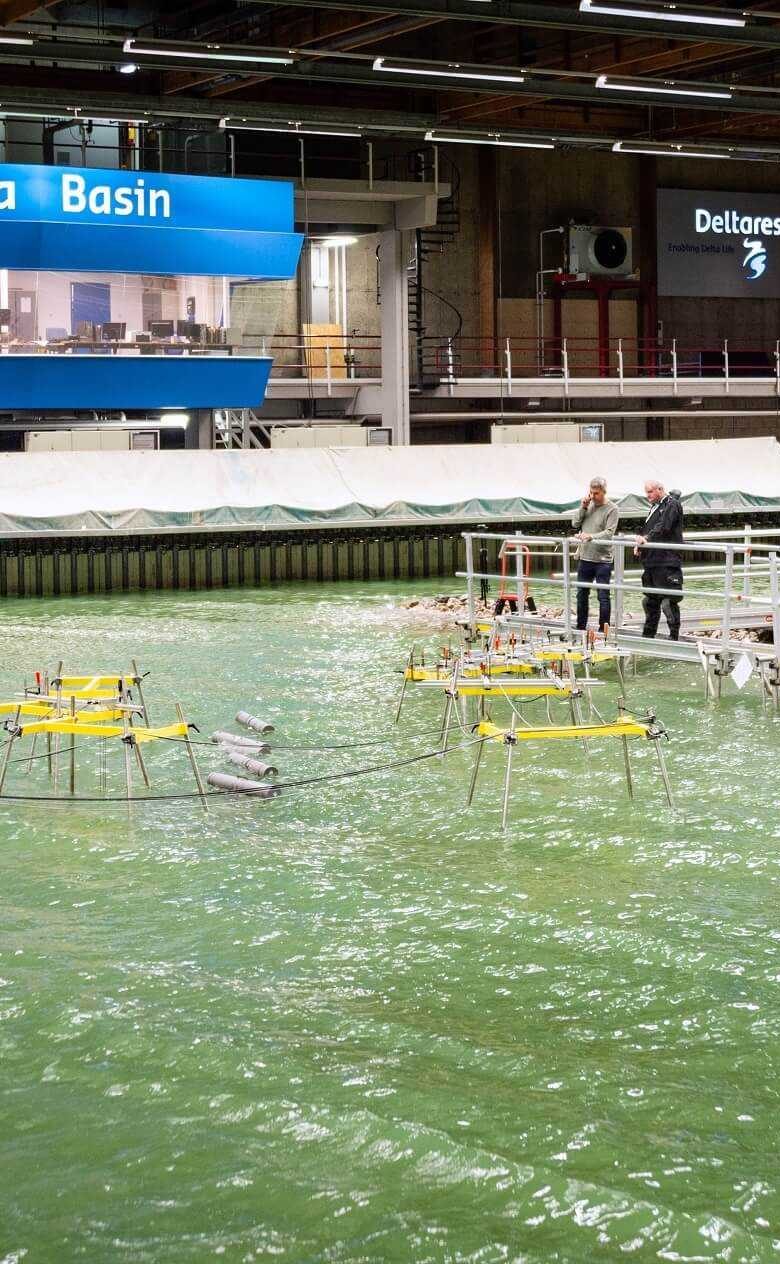Delta Basin
The Delta Basin (50 x 50 m) is a multidirectional wave basin with segmented wave paddles. The wave generator is capable of generating both regular (periodic) as irreguler (random) long-crested or short-crested waves according to both well-known frequency-directional distributions. The wave generator is equipped with online Active Reflection Compensation, which effectively eliminates re-reflections of waves from the wave board.

Also wave board control for random second-order waves is operational to compensate for spurious waves. The active wave absorption system accounts for 3D effects and short-waves effects. This means that the direction of the reflected waves propagating towards the wave board is accounted for and that the reflected waves propagating towards the wave board are absorbed accounting for short-waves effects and not only for long-waves effects.
Also, the Dalrymple Method is available, which enables generation of wave trains at a specified location, which effectively increases the model area that can be used.
Application areas
The influence of 3D wave attack on structures can be substantial. To study phenomena related to such conditions the Delta Basin is very suitable, because of its large dimensions. Both waves, current and a combination of these can be generated.
The Delta Basin is used for coastal and offshore related projects. In all of these studies, aspects of armour stability, hydraulic performance, wave impact loading, and the determination of the relevant hydraulic conditions for design purposes were of primary interest.
Typical studies
Typical studies for the Delta Basin are related to:
- Breakwaters; 3D stability, breakwater roundhead
- Jetties; wave pressures and wave forces on piles and decks of Jetties
- Revetments
- Wave climate studies
- Wave agitation into harbours
- Moored ship studies
- Scour and mobile bed studies
- Dune erosion and coastal beach protection schemes
Examples of studies in the Delta Basin
Wave overtopping at caisson breakwaters reduces significantly under oblique wave attack compared to perpendicular wave attack. In this video physical model tests are being performed in the high-tech Delta Basin at Deltares to develop new guidelines for the influence of oblique wave attack on caisson breakwaters under sea and swell conditions.
Recurved parapets can reduce the amount of wave overtopping. Adding a recurved parapet to an existing breakwater can be a suitable climate adaption measure in case of unforeseen sea level rise. However, the effect of a recurved parapet reduces for oblique waves. For simultaneous sea and swell conditions with different wave directions a method is proposed to account for the presence of swell.
You have not yet indicated whether you want to accept or reject cookies. This means that this element cannot be displayed.
Or go directly to:
Oblique wave attack can significantly reduce the amount of wave overtopping at dykes compared to perpendicular wave attack. In a study physical model tests have been performed in the Delta Basin to develop new guidelines for the influence of oblique wave attack on dykes with a berm.
The newly derived guideline significantly improves the prediction of wave overtopping at dykes under oblique wave attack and it appears that the actual wave overtopping under oblique wave attack is lower than expected before.
You have not yet indicated whether you want to accept or reject cookies. This means that this element cannot be displayed.
Or go directly to:
Technical specifications:
Wave basin
- Horizontal dimensions: 50 x 50 m
- Maximum water depth: 1.0 m
Wave generator
- Segmented piston-type wave boards
- Number of segments: 100
- Length of wavemaker: 40 m
- Stroke: 1.2 m
- Equipped with 3D Active Reflection Compensation
Wave characteristics
- Wave directions: between -50 and 50 degrees
- Maximum regular wave height Hmax,r: 0.45 m
- Maximum focussed wave height Hmax,f: 0.6 m
- Maximum significant wave height Hm0: 0.25 m

